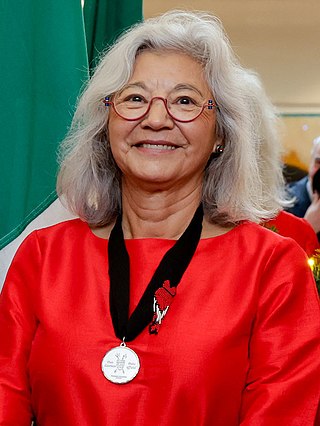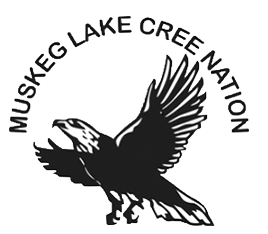Related Research Articles
Freda Ahenakew was a Canadian author and academic of Cree descent. Ahenakew was considered a leader in Indigenous language preservation and literary heritage preservation in Canada. She was a sister-in-law to the political activist David Ahenakew.
Lorna Brown is a Canadian artist, curator and writer. Her work focuses on public space, social phenomena such as boredom, and institutional structures and systems.
Lori Blondeau is a Cree/Saulteaux/Métis artist working primarily in performance art, but also in installation and photography. Blondeau is a member of the Gordon First Nation, and is based in Winnipeg, Manitoba.
Edward Poitras is a Métis artist based in Saskatchewan. His work, mixed-media sculptures and installations, explores the themes of history, treaties, colonialism, and life both in urban spaces and nature.
Sherry Farrell Racette is a First Nations feminist scholar, author, curator, and artist. She is best known for her contributions to Indigenous and Canadian art histories. She is currently an associate professor of Visual Arts at the University of Regina.

Louise Bernice Halfe, is a Cree poet and social worker from Canada. Halfe's Cree name is Sky Dancer. At the age of seven, she was forced to attend Blue Quills Residential School in St. Paul, Alberta. Halfe signed with Coteau Books in 1994 and has published four books of poetry: Bear Bones & Feathers (1994), Blue Marrow (1998/2005), The Crooked Good (2007) and Burning in this Midnight Dream (2016). Halfe uses code-switching, white space, and the stories of other Cree women in her poetry. Her experience at Blue Quills continues to influence her work today. Halfe's books have been well-received and have won multiple awards.
Ruth Cuthand D.F.A. is a Canadian artist of Plains Cree and Scots ancestry. She is considered an influential feminist artist of the Canadian prairies, and is lauded for her interpretation of racism and colonialism. Her work challenges mainstream perspectives on colonialism and the relationships between settlers and Indigenous people in a practice marked by political invective, humour, and a deliberate crudeness of style.

Michelle LaVallee is a Canadian curator, artist, and educator. She is Ojibway and a member of the Chippewas of Nawash Unceded First Nation in Cape Croker, Ontario. She has BFA (2000) and BEd (2004) degrees from York University in Toronto.
Mary Longman is a Canadian artist. She is of Saulteaux heritage from the Gordon First Nation. Her Aboriginal name is Aski-Piyesiwiskwew. She is known for her sculptures, drawings, and paintings, which examine political, cultural, spiritual and environmental issues related to the experiences of Aboriginal people and colonialism, including the Sixties Scoop and residential schools.

Cheryl L'Hirondelle is a Canadian multidisciplinary media artist, performer, and award-winning musician. She is of Métis/Cree (non-status/treaty), French, German, and Polish descent. Her work is tied to her cultural heritage. She explores a Cree worldview or nêhiyawin through body, mind, emotions, and spirit; examining what it means to live in contemporary space and time.
Tania Willard is an Indigenous Canadian multidisciplinary artist, graphic designer, and curator, known for mixing traditional Indigenous arts practices with contemporary ideas. Willard is from the Secwepemc nation, of the British Columbia interior, Canada.
Morgan Wood is a curator and artist who is Stony Mountain Cree. Her family is from the Michel Callihou Band in Alberta and her great-grandmother was Victoria Callihou. Wood received a Bachelor of Indian Art from the First Nations University of Canada, at the University of Regina in Regina, Saskatchewan.
Tanya Lukin Linklater is an artist-choreographer of Alutiiq descent. Her work consists of performance collaborations, videos, photographs, and installations.
Tarah Hogue is a Canadian curator and writer known for her work with Indigenous art. Hogue is of Métis and settler ancestry and resides in Saskatoon, Saskatchewan. She is the inaugural Curator at Remai Modern.
Richelle Bear Hat is a Blackfoot and Cree artist, based in Calgary, Alberta, Canada, on Treaty 7 territory. Bear Hat's work explores the ancestral transmission of knowledge, memory, and Indigenous relationships to land. According to curator Kristy Trinier, "her practice investigates ideas surrounding family relationships and the types of knowledge that are capable of being passed through them. These ideas are explored through the use of photography, transfers, video and paper based works. It is important to use materials and means of production that support the transference of memory and provide a platform for storytelling."
Barry Ace is a First Nations sculptor, installation artist, photographer, multimedia artist, and curator from Sudbury, Ontario, who lives in Ottawa. He is Odawa, an Anishinaabe people, and belongs to the M'Chigeeng First Nation.

The Muskeg Lake Cree Nation is a Cree First Nation band government in Marcelin, Saskatchewan, Canada.
Amy Malbeuf is a Canadian-Métis visual artist, educator, and cultural tattoo practitioner born in Rich Lake, Alberta.
Michelle Jacques is a Canadian curator and educator known for her expertise in combining historical and contemporary art, and for her championship of regional artists. Originally from Ontario, born in Toronto to parents of Caribbean origin, who immigrated to Canada in the 1960s, she is now based in Saskatoon, Saskatchewan.
Michelle Sound is a multidisciplinary Cree and Métis artist, educator and mother, living and working in Vancouver, British Columbia, Canada. Using a wide range of mediums—including photography, painting, textile art, beadwork, drum making, and caribou hair tufting—Sound's works often explore her Cree and Métis identity from a personal experience rooted in place, family, and history. Utilizing both traditional and contemporary materials and techniques, she considers notions of maternal labour, and cultural knowledge and inheritances, while highlighting that acts of care and joy are situated in family and community.
References
- ↑ "The risks of building forts and jumping ropes… by Angela Marie Schenstead". tea&bannock. 20 December 2016. Retrieved 14 March 2018.
- 1 2 3 "Joi Arcand – Plains Cree". Contemporary North American Indigenous Artists. Retrieved 14 March 2018.
- ↑ "Bite Sizes: Joi T. Arcand". pluginicasummerinstitute.blogspot.ca. 9 August 2017. Retrieved 14 March 2018.
- ↑ Budney, Vincent J. (2008). Flatlanders: Saskatchewan Artists on the Horizon. Saskatoon, Saskatchewan: Mendel Art Gallery. p. 9.
- ↑ "Joi T. Arcand | www.g101.ca". www.gallery101.org. Retrieved 27 July 2017.
- ↑ "Curator's Biography | Wally Dion: Mapping Me In …". kelownaartgallery.com. Retrieved 11 March 2017.
- ↑ "Tumblr".
- ↑ Morin, Chris (28 January 2013). "Kimiwan Zine Showcases Saskatoon's Indigenous Artists". Ominocity. Retrieved 14 March 2017.
- ↑ Crane, Meg (11 March 2014). "Expanding kimiwan – outwords". outwords. Retrieved 11 March 2017.
- ↑ "nipê wânîn – Saskatchewan Book Awards". www.bookawards.sk.ca. Retrieved 14 March 2018.
- ↑ "Joi Arcand – Plains Cree". Contemporary North American Indigenous Artists. Retrieved 27 July 2017.
- ↑ University, OCAD (26 September 2017). "Indigenous Visual Culture's Nigig Visiting Artist: Joi T. Arca..." www2.ocadu.ca. Retrieved 14 March 2018.
- ↑ Macaulay, Patrick. "Combine (main gallery)". harbourfrontcentre. Retrieved 7 March 2015.
- ↑ Gay, Felicia Deirdre. "The red shift : a contemporary Aboriginal curatorial praxis". University of Saskatchewan. Archived from the original on 2 April 2015. Retrieved 7 March 2015.
- 1 2 "ᓇᒨᔭ ᓂᑎᑌᐧᐃᐧᓇ ᓂᑕᔮᐣ". www.banffcentre.ca. Retrieved 27 July 2017.
- ↑ "In huge neon, Joi Arcand is rewriting everyday signs – in Cree | CBC Arts". CBC. Retrieved 14 March 2018.
- ↑ Lizard, Visual. "Upcoming | Winnipeg Art Gallery". wag.ca. Retrieved 14 March 2018.
- ↑ "The Optics of the Language: How Joi T. Arcand Looks with Words". Canadian Art. Retrieved 14 March 2018.
- ↑ "Saskatchewan cousins have 'amazing' time on Portlandia set". CBC News. Retrieved 11 March 2017.
- ↑ Heritage, Canadian (27 September 2017). "Temporary exhibits – Public art and monuments". aem. Retrieved 11 October 2019.
- ↑ "Four Outstanding Indigenous Artists Create Giant Murals in Canada's Capital Region". CHC|CPC. 25 June 2018. Retrieved 11 October 2019.
- ↑ Taking Care of Oneself – Nākatēyimisowin , retrieved 11 October 2019
- ↑ Nomadeandmode (28 October 2018). "Joi T Arcand | visual artist & Mad Aunty jewellery designer". Nomade & Mode. Retrieved 25 March 2019.
- ↑ Simpson, Peter. "They came, they SAW and they renovated: Gallery in Arts Court gets a facelift – ARTSFILE" . Retrieved 25 March 2019.
- ↑ Gushue, Brittany. "History, identity explored at Gallery 101 double exhibition – The Charlatan, Carleton's independent newspaper". charlatan.ca. Retrieved 11 March 2017.
- ↑ "Dunlop Art Gallery Exhibitions :: Current Exhibitions". www.dunlopartgallery.org. Retrieved 11 March 2017.[ permanent dead link ]
- ↑ "Official Language – Joi Arcand". Wanuskewin Heritage Park. 2014. Archived from the original on 12 March 2017. Retrieved 9 March 2017.
- ↑ Longman, Mary (2016). "Joi T. Arcand: Through That Which Is Scene". Klondike Institute of Art and Culture Blog.[ permanent dead link ]
- ↑ "Language of Puncture | www.g101.ca". www.gallery101.org. Retrieved 14 March 2018.
- ↑ "When Raven Became Spider | Wanuskewin Heritage Park". Archived from the original on 31 May 2019. Retrieved 25 March 2019.
- ↑ Lizard, Visual. "Upcoming | Winnipeg Art Gallery". wag.ca. Retrieved 17 April 2018.
- ↑ "Àbadakone – Continuous Fire – Feu continuel – National Gallery of Canada". Nationak Gallery of Canada. Retrieved 9 November 2019.
- ↑ "2018 Sobey Art Award: Prairies & North – Joi T. Arcand". CBC Radio. 29 January 2019. Retrieved 25 January 2020.